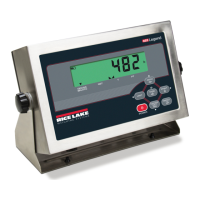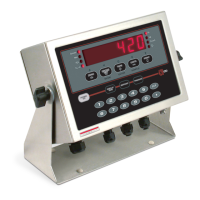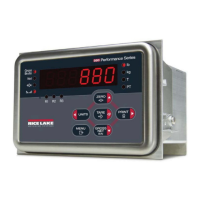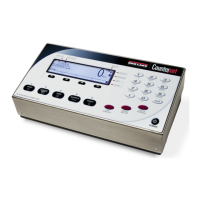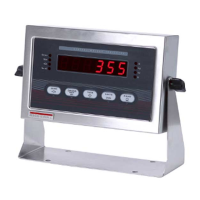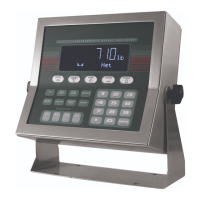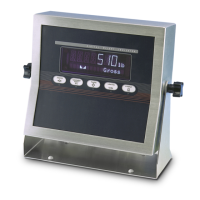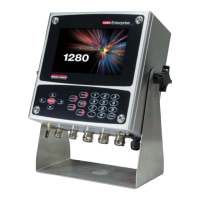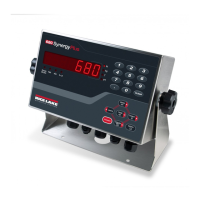Do you have a question about the Rice Lake 480Plus-2A and is the answer not in the manual?
Safety Symbol Definitions and general safety precautions.
Describes the 480 indicator's features and supported applications.
Details the four operating modes: Weigh, Configuration, User Menu, and Test.
Shows and describes the front panel keypad layout.
Lists the function of each key on the front panel.
Explains the meaning of each LED annunciator on the display.
Describes how to navigate menus using front panel keys.
Details how to edit numeric values using the keypad.
Basic operations like Menu navigation, Zero Scale, Acquire Tare.
Explains how to enter a preset tare value.
Describes how to display a stored tare value.
Explains how to print a ticket with gross or net format.
Describes switching between gross and net display modes.
Explains how to view the audit trail.
Details how to enter or edit the Unit ID.
Describes how to view and manage the accumulator.
Explains how to set and view time and date.
Details how to configure setpoints.
Explains how to view the firmware version.
Describes how to set or change the user password.
Instructions for unpacking and inspecting the indicator.
Guides on how to open the indicator enclosure.
Details on connecting cables through cord grips.
Explains how to properly ground shielded cables.
Diagrams and explanations of board wiring and connections.
Information on using and charging the internal battery.
Steps for installing optional modules like Analog Output or Relay Board.
Procedure for removing internal boards from the indicator.
Instructions for reassembling the indicator enclosure after servicing.
Details on sealing the indicator for Legal for Trade approval.
Lists and illustrates the available replacement parts.
Explains how to access and use the User Menu.
Details the setup for setpoint parameters.
Describes serial port configuration options.
Details configuration for Ethernet ports.
Describes configuration options for the USB port.
Explains how to customize print formats.
How to view the firmware version.
Miscellaneous configuration settings like Power, Backlight, Battery.
Overview of front panel configuration menus and methods.
Details structure and parameters of the CONFIG menu.
Configuration of adaptive and rolling filters.
Configuration of primary and secondary units, decimal points.
Menu structure for calibrating the indicator.
Configuration of power-up, regulatory, and sleep modes.
Configuration of functions for digital inputs.
Configuration for the analog output module.
Setting and editing configuration and user passwords.
Information about USB memory features (future versions).
Accessing diagnostic functions and tests.
Step-by-step guide to calibrating via the front panel.
Details calibration using EDP commands.
Describes calibration using the Revolution utility.
Additional information on WVAL and final calibration adjustments.
Steps to connect Revolution to the indicator.
How to save and transfer configuration data using Revolution.
Instructions for updating firmware using the flash loader.
Overview of the EDP command structure and groups.
Lists EDP commands that simulate front panel key presses.
Lists EDP commands for retrieving data and status.
Command to restore default configuration parameters.
Commands to display or change configuration parameters.
Command to soft reset the indicator without losing configuration.
Commands for transmitting data in normal mode.
Lists tokens used to customize print format strings.
Procedures for customizing print formats using the PFORMT menu.
Explains batch and continuous setpoint operation.
Lists and explains front panel error messages and their solutions.
Detailed list of error messages and their meanings.
How to query error conditions remotely using EDP commands.
Describes status messages provided by P and ZZ EDP commands.
Defines formats for continuous data streaming.
Configuration for local/remote operation modes.
Information on tracking configuration and calibration events.
Details on the indicator's low-power sleep mode.
Information about the optional internal rechargeable battery.
Overview of USB connectivity options (Device, Host, Printer).
Details connecting to a PC via USB in HOST mode.
Instructions for using USB flash drives for configuration.
How to connect and print to a USB printer.
Information on the optional Ethernet connectivity.
Explains unit conversion and its configuration.
Information on digital filters for stable readings.
Setting the A/D sample rate for digital filtering.
Configuration of adaptive filter sensitivity and threshold.
Details on rolling averaging filter stages and parameters.
Procedure for calibrating the analog output module.
Accessing diagnostic functions and tests.
Explains how regulatory modes affect tare and zero functions.
Lists ASCII character values for print formatting.
Shows the seven-segment LED character set.
Technical specifications of the 480 indicator.
Safety Symbol Definitions and general safety precautions.
Describes the 480 indicator's features and supported applications.
Details the four operating modes: Weigh, Configuration, User Menu, and Test.
Shows and describes the front panel keypad layout.
Lists the function of each key on the front panel.
Explains the meaning of each LED annunciator on the display.
Describes how to navigate menus using front panel keys.
Details how to edit numeric values using the keypad.
Basic operations like Menu navigation, Zero Scale, Acquire Tare.
Explains how to enter a preset tare value.
Describes how to display a stored tare value.
Explains how to print a ticket with gross or net format.
Describes switching between gross and net display modes.
Explains how to view the audit trail.
Details how to enter or edit the Unit ID.
Describes how to view and manage the accumulator.
Explains how to set and view time and date.
Details how to configure setpoints.
Explains how to view the firmware version.
Describes how to set or change the user password.
Instructions for unpacking and inspecting the indicator.
Guides on how to open the indicator enclosure.
Details on connecting cables through cord grips.
Explains how to properly ground shielded cables.
Diagrams and explanations of board wiring and connections.
Information on using and charging the internal battery.
Steps for installing optional modules like Analog Output or Relay Board.
Procedure for removing internal boards from the indicator.
Instructions for reassembling the indicator enclosure after servicing.
Details on sealing the indicator for Legal for Trade approval.
Lists and illustrates the available replacement parts.
Explains how to access and use the User Menu.
Details the setup for setpoint parameters.
Describes serial port configuration options.
Details configuration for Ethernet ports.
Describes configuration options for the USB port.
Explains how to customize print formats.
How to view the firmware version.
Miscellaneous configuration settings like Power, Backlight, Battery.
Overview of front panel configuration menus and methods.
Details structure and parameters of the CONFIG menu.
Configuration of adaptive and rolling filters.
Configuration of primary and secondary units, decimal points.
Menu structure for calibrating the indicator.
Configuration of power-up, regulatory, and sleep modes.
Configuration of functions for digital inputs.
Configuration for the analog output module.
Setting and editing configuration and user passwords.
Information about USB memory features (future versions).
Accessing diagnostic functions and tests.
Step-by-step guide to calibrating via the front panel.
Details calibration using EDP commands.
Describes calibration using the Revolution utility.
Additional information on WVAL and final calibration adjustments.
Steps to connect Revolution to the indicator.
How to save and transfer configuration data using Revolution.
Instructions for updating firmware using the flash loader.
Overview of the EDP command structure and groups.
Lists EDP commands that simulate front panel key presses.
Lists EDP commands for retrieving data and status.
Command to restore default configuration parameters.
Commands to display or change configuration parameters.
Command to soft reset the indicator without losing configuration.
Commands for transmitting data in normal mode.
Lists tokens used to customize print format strings.
Procedures for customizing print formats using the PFORMT menu.
Explains batch and continuous setpoint operation.
Lists and explains front panel error messages and their solutions.
Detailed list of error messages and their meanings.
How to query error conditions remotely using EDP commands.
Describes status messages provided by P and ZZ EDP commands.
Defines formats for continuous data streaming.
Configuration for local/remote operation modes.
Information on tracking configuration and calibration events.
Details on the indicator's low-power sleep mode.
Information about the optional internal rechargeable battery.
Overview of USB connectivity options (Device, Host, Printer).
Details connecting to a PC via USB in HOST mode.
Instructions for using USB flash drives for configuration.
How to connect and print to a USB printer.
Information on the optional Ethernet connectivity.
Explains unit conversion and its configuration.
Information on digital filters for stable readings.
Setting the A/D sample rate for digital filtering.
Configuration of adaptive filter sensitivity and threshold.
Details on rolling averaging filter stages and parameters.
Procedure for calibrating the analog output module.
Accessing diagnostic functions and tests.
Explains how regulatory modes affect tare and zero functions.
Lists ASCII character values for print formatting.
Shows the seven-segment LED character set.
Technical specifications of the 480 indicator.
| Brand | Rice Lake |
|---|---|
| Model | 480Plus-2A |
| Category | Accessories |
| Language | English |
